One of the pillars of Freemasonry is rational investigation into various subjects that permeate and are of common interest to the order.
Ritualism is a central part of the Masonic body, being present and justifying all sessions. For the work to occur in a coherent manner, rigorous investigation into each aspect of the ritual is necessary.
This research is carried out by many Freemason-ologists, aiming at improving and necessary corrections in the execution of procedures and textual fragments contained in the rituals. As technology advances, research also advances and new sources are found that serve to improve order.
Despite such efforts, it is common to see some errors in ritualistic execution that should have already been overcome, but which, for reasons beyond their control, remain extremely strong in the Brazilian Masonic environment, insistently, in a way that ignores facts and reason.
One of these examples, quite popular, is the use of the Hebrew word בעז (Boaz), which in some ritualistic executions finds space to be pronounced as the corruption ‘Booz’.
In view of this, aiming at ritualistic improvement and consequently presenting the facts about the Hebrew word, below an analysis will be carried out through other works and research originating from the Masonic environment and also from various translations of the Bible the word בעז.
Some considerations about Hebrew
The starting point of the research seeks to present a general overview of the word בעז. The name Boaz derives from the following biblical passage that was originally written in Hebrew:
“Then he set up the pillars in the porch of the temple; and raising up the right column, he called its name Jachin; and lifting up the left pillar, he called his name Boaz” (1 Kings 7:21).
When it comes to the number of times the word Boaz appears in the Bible, there are 25 times in the Old Testament and 2 in the New Testament. According to the Biblical Concordance (1975, p. 107) they are divided as follows: Twenty-one (21) citations in the book of Ruth; One (1) in the book of 1 Kings; Two (2) in the book of 1 Chronicles; One (1) in the book of 2 Chronicles; One (1) in the Gospel of Matthew and one (1) in the Gospel of Luke.
They appear subdivided into two basic spellings: Bho`az בֹעַז and Bo`az בֹּעַז. This small variation in the initial letter, which can be read aspirated or not, is common in Hebrew.
It is worth noting that both forms are written with Pataḥ, a Hebrew vowel sign (niqqud) represented by a horizontal line below a letter (אַ). In Hebrew, it indicates the phoneme that is close to the sound “a”.
Hebrew today has thirteen (13) dialects, which have many phonetic differences between them. However, when it comes to Patah, all these systems that use masoretic signs pronounce it equally with the “a” sound.
It is important to highlight that the object of study of this work is motivated by a translation of the bible called the Vulgate, as it is in it that the word written with the spelling “Booz” appears for the first time.
The Vulgate is the translation of the Bible from Greek to Latin. It was produced between the end of the 4th century AD. and the beginning of the 5th a.d., by Jerome, an important theologian and priest of the Catholic Church, in accordance with the determination of Pope Damasus I. This is the version that began to be used officially by the Church in that context.
In the first centuries of the Christian Church, the language in predominant use was Greek. It is the Latin translation of the Vulgate that consolidates the use of the Latin version.
The term “Booz” appeared when the Bible was translated into Latin, caused by a mistake by Jerome when registering Booz instead of Boaz.
The consecration and conservation in some cases of this corruption is explained because the Catholic Church, claiming “respect” for the biblical translator, decided to maintain the Vulgate tradition, that is, it maintained the mistaken term Booz in place of the correct Boaz (JUK, 2018).
Analysis of Masonic texts and the choice of use of the word Boaz
Many literary productions from the speculative period of Freemasonry also dedicated space to the analysis of these words. In the North American Masonic edition of the Holy Bible (Heirloom Bible Publishers, Kansas), the term presented is Boaz.
Works such as:
Light On Masonry (1828) by Elder D. Bernard,
the Encyclopedia Of Freemasonry (1917) by the exponent Albert Mackey,
the Manual of Freemasonry (1825), by Richard Carlile (an exposée of Freemasonry published gradually in The Republican magazine),
Morals and Dogma (1871) by Albert Pike,
and The Complete Ritual of the Scottish Rite Profuselly Illustrated, edited by a Sovereign Grand Commander (anonymous) and complemented by J. Blanchard, in the 19th century,
are some of the examples where authors also use Boaz (PEÑALOZA, 2019).
Harry Carr in his article Pillars and globes, columns and candlesticks, published in Ars Quatuor Coronatorum, Transactions of the Quatuor Coronati Lodge № 2076 London, in 2001, and presented earlier at the Vancouver Lodge of Education and Research, on November 20, 1998, states that the word is Boaz.
In this article, Harry Carr reproduces some excerpts from expositions published between 1760 and 1765, in which the term is Boaz (PEÑALOZA, 2019)
According to the Masonic magazine Pietre-Stones – Review of Freemasonry, cited in a work done by Freemason author and researcher William Almeida de Carvalho (2008), the first Masonic ritual published in the world in a clandestine way that caused commotion was Masonry Dissected, by Samuel Prichard, in 1730. On page 18 of this repository of information from the 18th century there is the word Boaz.

Prichard, Samuel. Masonry dissected. London: Wilford, 1730 in Carr, Henry. World of Freemansonry. London: Lewis Masonic, 1985.
IMAGE LINKED: wikimedia Attribution 4.0 International (CC BY 4.0)
Still in the 18th century, the classic Three Distinct Knocks (1760) stated: “the senior and junior Warden have each of them a Column in their Hand, about Twenty Inches long, which represents the two Columns of the Porch at Solomon’s Temple . Boaz and Jachin”.
The French in the 19th century also used the translation Boaz. Several rituals in France in the 18th and 19th centuries, the most famous and rare being the one entitled Delaunaye (1821, p. 370) presents several words in Hebrew with the name corrupted and the name rectified: “Noms corrompus: BOOZ; Noms rectifiés: BOHAZ; Leur signification: en Force”.
The Philalethes magazine of the Philalethes Society in the USA, founded in 1928 and which brings together scholars of North American Freemasonry, also only uses Boaz, as noted in the article The Great Pillar, by Harry L. Haywood:
the names ‘jachin’ and ‘boaz’ by which the two pillars at Solomon’s Temple were known, were in each instance a Hebrew form of those old Semitic root-terms. The Hebrews had their own language, religion, culture, but they all had come to them by inheritance, to a large extent, from the older peoples of the Near East, just as our own language, religion, and culture, thought it is peculiarly our own, came to us from Europe and Britain.
Still in North American writings, their two best encyclopedias on Masonic subjects ignore the word Booz. Albert Mackey in his Encyclopedia of Freemasonry, analyzing the entry Boaz (there is no Booz) states: “Boaz. The name of the left hand pillar that stood at the porch of King Solomon´s Temple” .
Henry Wilson Coil in his famous Coil’s Masonic Encyclopedia, in the entry Boaz that refers to Pillars and Columns, presents the following: “The Two Pilllars or Columns, Jachin and Boaz, with their Pannels”. (CARVALHO, 2008).

Jachin and Boaz (1762)
IMAGE LINKED: wikimedia Attribution 4.0 International (CC BY 4.0)
Analysis of various Bible translations
Since it concerns a word contained in the Bible, it is important to analyze the various available translations, observing how each one deals with the word Boaz בעז.
The Bible translation made by Martin Luther includes the word Boaz in the title of chapter two of Ruth: “Rut liest Ähren auf dem Feld des Boaz.”
It also includes the citation:
“Es war aber ein Mann, ein Verwandter des Mannes der Noomi, von dem Geschlecht Elimelechs, mit Namen Boaz; der war ein angesehener Mann.”
Luther translated the text of 1 Kings 7:21 as: “Und er richtete die Säulen auf vor der Vorhalle des Tempels; die er zur rechten Hand setzte, nannte er Jachin, und die er zur linken Hand setzte, nannte er Boas” (CARVALHO, 2008).
The English King James Version maintains the word Boaz: “Ruth Works in the Field of Boaz”, and the first verse of Ruth 2 was translated as:
“And Naomi had a kinsman of her husband’s, a mighty man of wealth, of the family of Elimelech; and his name was Boaz.”
The verse from 1 Kings 7:21 also mentions the use of Boaz:
“And he set up the pillars in the porch of the temple: and he set up the right pillar, and called the name thereof Jachin: and he set up the left pillar, and he called the name thereof Boaz” (CARVALHO, 2008).
The Portuguese version of the Bible, translated by João Ferreira de Almeida, mentions:
“Naomi had a relative of her husband’s, a man of great wealth, of the family of Elimelech; his name was Boaz” (BÍBLIA, 1969, p. 288).
The verse from 1 Kings 7:21 was translated by the author as follows:
“Then he set up the columns at the portico of the temple, having set up the right column, he named it Jachin; and having set up the left column, he named it Boaz” (BÍBLIA, 1969, p. 365).
For a more detailed analysis, here are several other translations of the text of 1 Kings 7:21, from the Bible in Portuguese:
[Pt] Nova Tradução na Linguagem de Hoje: “Hurã colocou essas duas colunas de bronze na frente da entrada do Templo. A que ficava no lado sul se chamava Jaquim, e a que ficava no lado norte se chamava Boaz.”
[En] Nova Tradução na Linguagem de Hoje: “Hurã placed these two bronze columns in front of the entrance of the Temple. The one on the south side was named Jachin, and the one on the north side was named Boaz.”
[Pt] Nova Versão Internacional: “Ele levantou as colunas na frente do pórtico do templo. Deu o nome de Jaquim à coluna ao sul e de Boaz à coluna ao norte”
[En] Nova Versão Internacional: “He set up the columns in front of the portico of the temple. He named the south column Jachin and the north column Boaz.”
[Pt] João Ferreira de Almeida Recebida: “Depois levantou as colunas no pórtico do templo; levantando a coluna direita, pôs-lhe o nome de Jaquim; e levantando a coluna esquerda, pôs-lhe o nome de Boaz.”
[En] João Ferreira de Almeida Recebida: “Then he set up the columns at the portico of the temple; having set up the right column, he named it Jachin; and having set up the left column, he named it Boaz.”
[Pt] João Ferreira de Almeida Corrigida Fiel: “Depois levantou as colunas no pórtico do templo; e levantando a coluna direita, pôs-lhe o nome de Jaquim; e levantando a coluna esquerda, pôs-lhe o nome de Boaz.”
[En] João Ferreira de Almeida Corrigida Fiel: “Then he set up the columns at the portico of the temple; having set up the right column, he named it Jachin; and having set up the left column, he named it Boaz.”
[Pt] João Ferreira de Almeida Revista e Atualizada: Depois, levantou as colunas no pórtico do templo; tendo levantado a coluna direita, chamou-lhe Jaquim; e, tendo levantado a coluna esquerda, chamou-lhe Boaz.
[En] João Ferreira de Almeida Revista e Atualizada: “Then he set up the columns at the portico of the temple; having set up the right column, he named it Jachin; and having set up the left column, he named it Boaz.”
[Pt] Nova Versão Transformadora: “Hirão colocou as colunas na entrada do templo, uma à direita e outra à esquerda. À que estava à direita deu o nome de Jaquim; e à outra, à esquerda, deu o nome de Boaz.”
[En] Nova Versão Transformadora: “Hiram placed the columns at the entrance of the temple, one on the right and one on the left. He named the one on the right Jachin and the one on the left Boaz.”
[Pt] Almeida Revista e Corrigida (1969): “Depois levantou as colunas no pórtico do templo; e levantando a coluna direita, chamou o seu nome Jaquim; e levantando a coluna esquerda, chamou o seu nome Boaz.”
[En] Almeida Revista e Corrigida (1969): “Then he set up the columns at the portico of the temple; having set up the right column, he named it Jachin; and having set up the left column, he named it Boaz.”
Some international versions of the Bible in languages of Latin, Anglo-Saxon, and Semitic origin, which also chose to use Boaz:
Reina Valera Spanish Translation: “Estas columnas erigió en el pórtico del templo: y cuando hubo alzado la columna de la mano derecha, púsole por nombre Jachîn: y alzando la columna de la mano izquierda, llamó su nombre Boaz.”
[En] “He erected these columns at the portico of the temple: and when he had raised the right-hand column, he named it Jachin: and raising the left-hand column, he named it Boaz.”
Bible for Esperanto: “Kaj li starigis la kolonojn antaŭ la salono de la templo; kaj li starigis la dekstran kolonon kaj donis al ĝi la nomon Jaĥin; kaj li starigis la maldekstran kolonon kaj donis al ĝi la nomon Boaz.”
[En] “And he set up the columns in front of the temple hall; and he set up the right column and named it Jachin; and he set up the left column and named it Boaz.”
La Nuova Diodati (1991): “Poi installò le colonne nel portico del tempio; installò la colonna sulla destra e la chiamò Jakin, quindi installò la colonna di sinistra e la chiamò Boaz.”
[En] “Then he installed the columns in the portico of the temple; he installed the right column and named it Jachin, then he installed the left column and named it Boaz.”
Polska Bible: “I postawił one słupy w przysionku kościelnym; a postawiwszy słup prawy, nazwał imię jego Jachin; postawiwszy zaś słup lewy, nazwał imię jego Boaz.”
[En] “And he set up the columns in the church vestibule; and having set up the right column, he named it Jachin; and having set up the left column, he named it Boaz.”
Haitian Creole Bible: “Iram mete poto yo kanpe devan pòt antre Tanp lan, yonn sou bò dwat, yonn sou bò gòch. Li rele sa ki sou bò dwat la Jaken, sa ki sou bò gòch la Boaz.”
[En] “Hiram set up the columns in front of the entrance of the Temple, one on the right, one on the left. He called the one on the right Jachin, the one on the left Boaz.”
1933/1953 Afrikaans Bybel: “En hy het die pilare opgerig by die voorportaal van die hoofvertrek. Toe hy die regterpilaar opgerig het, noem hy dit Jagin; en toe hy die linkerpilaar opgerig het, noem hy dit Boas.”
[En] “And he erected the pillars at the vestibule of the main hall. When he had erected the right pillar, he named it Jachin; and when he had erected the left pillar, he named it Boaz.”
Albanian Version: “Pastaj vendosi shtyllat në portikun e tempullit; vendosi shtyllën në të djathtë dhe e quajti Jakin, pastaj vendosi shtyllën në të majtë dhe e quajti Boaz.”
[En] “Then he set up the columns in the portico of the temple; he set up the right column and named it Jachin, then he set up the left column and named it Boaz.”
Finnish Translation: “Salomo sijoitti pylväät temppelisalin eteishalliin. Sille, jonka hän pystytti oikealle puolelle, hän antoi nimeksi Jakin, ja vasemmanpuoleiselle hän antoi nimen Boas.”
[En] “Solomon placed the columns in the vestibule of the temple hall. The one he set up on the right he named Jachin, and the one on the left he named Boaz.”
French Bible Martin Translation: “Il dressa donc les colonnes au porche du Temple, et mit l’une à main droite et la nomma Jakin; et il mit l’autre à main gauche, et la nomma Boaz.”
[En] “He therefore set up the columns at the porch of the Temple, and placed one on the right and named it Jachin; and placed the other on the left and named it Boaz.”
Dutch Translation: “Daarna richtte hij de pilaren op in het voorhuis des tempels; en den rechter pilaar opgericht hebbende, zo noemde hij zijn naam Jachin, en den linker pilaar opgericht hebbende, zo noemde hij zijn naam Boaz.”
[En] “Then he set up the pillars in the vestibule of the temple; and having set up the right pillar, he named it Jachin, and having set up the left pillar, he named it Boaz.”
Translation into Romanian: “A aşezat stîlpii în pridvorul Templului; a aşezat stîlpul din dreapta, şi l -a numit Iachin; apoi a aşezat stîlpul din stînga, şi l -a numit Boaz.”
[En] “He set up the pillars in the vestibule of the Temple; he set up the right pillar and named it Jachin; then he set up the left pillar and named it Boaz.”
Turkish Translation: “Hiram sütunları tapınağın eyvanına dikip sağdakine Yakin, soldakine Boaz adını verdi.”
[En] “Hiram set up the columns in the portico of the temple, naming the one on the right Jachin and the one on the left Boaz.”
Tagalog Translation: “At kaniyang itinayo ang mga haligi sa portiko ng templo: at kaniyang itinayo ang kanang haligi, at pinanganlang Jachin: at kaniyang itinayo ang kaliwang haligi, at pinanganlang Boaz.”
[En] “And he set up the pillars at the portico of the temple: and he set up the right pillar and named it Jachin: and he set up the left pillar and named it Boaz.”
Swedish Translation: “Pelarna ställde han upp vid förhuset till tempelsalen. Åt den pelare han ställde upp på högra sidan gav han namnet Jakin, och åt den han ställde upp på vänstra sidan gav han namnet Boas.”
[En] “He set up the pillars at the vestibule of the temple hall. The pillar he set up on the right he named Jachin, and the one he set up on the left he named Boaz.”
Conclusion
In view of the above, based on the analysis of the term in Hebrew, the context in which the theologian Jerome was inserted when he translated the Old Testament directly into Latin, as well as notable texts from the speculative Masonic tradition and the various translations of the Bible, it can be – Strictly observe the transliteration and pronunciation used of the Hebrew word בעז as Boaz, while Booz, a pronunciation widely used in some regions and rites present in Brazilian Freemasonry, is an incorrect use.
This was due to a mistaken translation carried out by the Catholic translator, as only someone absolutely fluent in Hebrew could correctly read the text in its original language, which was not the case with Jerome.
The Catholic tradition maintains corruption in its versions of the Bible with respect to the translator to this day. Therefore, during ritualistic work it is necessary to follow the correct use of words, avoiding vices or traditions arising from exegetical errors of Masonic rituals and texts, as they are an important part of the reunion and in this way express the depth of the teachings contained in Masonic pedagogy.
Making use of reason and the correct word Boaz, Masonic rituals remain aligned and contextualized with the entire tradition and what it proposes.
Article by: Fernando Rodrigues de Souza

Master’s student in Religious Sciences at the Federal University of Sergipe. Religion Scientist. Specialist in History and Philosophy of Religion, Freemasonology and Active Methodologies in Teaching Education.
Instagram: @maconariaehistoria
Recent Articles: masonic history
 Protestantism and Masonic Influence in Brazil Discover the untold story of how Freemasons helped Southern Americans immigrate to Brazil post-Civil War, fostering economic and educational growth in Santa Bárbara d’Oeste and Americana. Learn about their pivotal role in establishing Protestant churches and ensuring the secularity of the Brazilian State amidst a Catholic-dominated society. |
 Explore the proper use of the sacred word in Brazilian Freemasonry through an analysis of Masonic literature and Bible translations. Uncover the errors in pronunciation and the need for corrections to maintain liturgical coherence in rituals. Discover insights on Masonry, rituals, and the Hebrew word Boaz. |
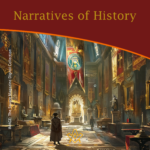 Narratives of History |
 A Very Royal Sesquicentenary |
 Unveiling the Enigma: Discover the Royal Society's Legacy and its Impact on Science. Delve into the fascinating history of the Royal Society, the prestigious UK academy shaping scientific progress since 1660. Explore its pivotal role in advancing knowledge, fostering collaboration, and unlocking the secrets of the universe. Prepare to be amazed! |
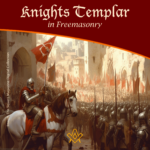 Knights Templar in Freemasonry Uncover the Mysteries of the Knights Templar in Freemasonry! Delve into the intriguing world where chivalry and symbolism intertwine. Discover the captivating rituals and ancient secrets behind the Knights Templar Masonic Orders. Explore the historical connection and delve into the enigmatic narratives that continue to fascinate enthusiasts today. Unveil the hidden truths now! |
 The Royal Arch stands as the rainbow of promise in the Ritual; it stands as the promise of the resurrection; of that which was lost and that it shall be recovered. The question arises as to whether the Master's Word was originally communicated in the Third Degree? On this point there is some diversity of opinion. Originally published in 1915, this insight into the Fourth Degree – the Holy Royal Arch – is as relevant today as it was over 100 years ago. |
 Unveiling the Mysteries of Druidism: Discover the Intriguing Connection with Freemasonry. Explore the ancient spiritual practice of Druidism and its fascinating ties to the enigmatic world of Freemasonry. Delve into the shared symbolism and rituals that have captivated minds for centuries. Unlock the secrets of these intertwined traditions today! |
 Uncover the legacy of freestone masons and their pivotal role in crafting medieval cathedrals. Discover the artistry behind their techniques, the hierarchy within their craft, and the enduring impact of their intricate carvings. A deep dive into the world of these master craftsmen awaits you! |
 Unearth the intriguing journey from Vincha Culture to Freemasonry. Discover how ancient building methods intertwine with modern Masonic philosophies. This exploration will shed light on the fascinating link between the Serbian term "shestarenye" and the symbolic significance of the compass in Freemasonry. |
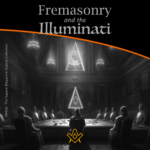 Freemasonry and the Illuminati Unravel the enigmatic world of Freemasonry and the Illuminati in our latest exposé. Dive into centuries-old mysteries, debunk conspiracy theories, and discover the truth behind these elusive societies. Are they puppet masters or mere myths? Join us as we dissect history and fact from fiction. |
 The Île des Templiers, or “Island of the Templars” lies within a leafy park in Paris. The execution site of Jacques du Molay, the last Grand Master of the Knights’ Templar bears a plaque with the epitaph ‘A cet endroit / Jacques de Molay / Dernier grand maître / de l'ordre du temple / a été brûlé le 18 Mars 1314’ (‘In this location / Jacques de Molay / Last grand master / of the order of the temple / was burned on 18 March 1314’) |
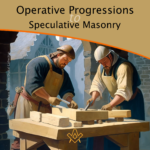 Operative Progressions to Speculative Masonry Both Operative and Speculative Masonry are an important part of the modern fraternity of Freemasonry, which combines elements of both traditions. Today, Freemasonry is a fraternity that is open to men of good character, who are interested in personal development and in making a positive contribution to their communities. |
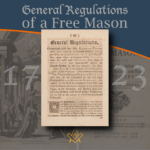 General Regulations of a Free Mason, 1723 General Regulations of a Free Mason as contained in Anderson's Constitutions of the Freemasons, published 1723. the Regulations are of great historical interest. Compiled by George Payne, the second Grand Master of the Premier Grand Lodge of England, they were printed in 1722/3, thus published just over five years after the formation of the Grand Lodge 1717. |
 The Genesis of the 1723 Book of Constitutions 2023, marks the three hundredth anniversary of the publication of the first printed Book of Constitutions of the Grand Lodge formally established in London two years previously. This is an anniversary whose significance extends beyond freemasonry. A paper by Andrew Prescott |
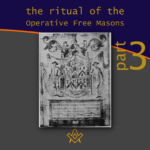 The Ritual of the Operative Free Masons - P3 Existing Operative Free Masons. The ritual I am about to refer, is that of "The Worshipful Society of Free Masons, Rough Masons, Wallers, Slaters, Paviors, Plaisterers, and Bricklayers." By Thomas Carr, M.D., P. M. Honorary Member of the Guild of Operative Free Masons |
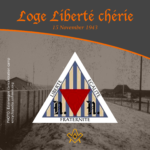 Liberté chérie was a Masonic Lodge founded in 1943 by Belgian Resistance fighters and other political prisoners at Esterwegen concentration camp. It was one of the few lodges of Freemasons founded within a Nazi concentration camp during the Second World War. |
 The Ritual of the Operative Free Masons - P2 If anyone doubts the fact that the formation of Speculative Free Masonry was due to and based upon Operative Free Masonry, it is quite easy to convince him of his error if he will only study the first Book of Constitutions. By Thomas Carr, M.D., P. M. Honorary Member of the Guild of Operative Free Masons |
 In 1881, Freemasonry rose from the ashes of a fire in the mining town of Kokomo, Summit County, Colorado. Corinthian Lodge No. 42, along with Kokomo, no longer exists but it holds the record of having been – at an elevation of 10,618 feet – the highest Masonic Lodge in the USA. |
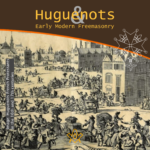 The Huguenots and Early Modern Freemasonry The Huguenots influence in the development of early modern Freemasonry at the time of the formation of the Grand Lodge in London around 1717 / 1723. |
 November is a month of reflection – perhaps due to the fact that we are getting close to the years' end – but also because Remembrance / Armistice Day (11 November) is a significant date in most countries' diaries. |
 Speculative Freemasonry, as practise by Grand Lodge of England, was officially born just over three hundred years ago, is today an international organisation, counting over six million members. It has been subjected to persecution, suppression, and abolition throughout its history. In its infancy, only a couple of decades after its official birth, it had already become a target. |
 The Ritual of the Operative Free Masons - P1 The original paper was written, first, to prove that Speculative Free Masonry was derived from Operative Free Masonry; second, to give some account of the Operative Free Masons, of their Ritual, and of their customs. By Thomas Carr, M.D., P. M. Honorary Member of the Guild of Operative Free Masons |
 American Fraternalism in the 19th and Early 20th Centuries The late 19th and early 20th centuries in the United States has been called the "Golden Age of Fraternalism." How did this come about and why was the idea of joining a fraternal organization so popular? We will explore this question and examine the regalia used by many fraternal organizations in this period. |
 Societas Draconistarum, meaning "Society of the Dragonists"– was a chivalric Order for selected nobility, founded in 1408 by Sigismund von Luxembourg, who through marriage became the King of Hungary (1387–1437) and later Holy Roman Emperor. The Order was fashioned after the military orders of the Crusades, requiring its initiates to defend the cross and fight the enemies of Christianity, in particular the Ottoman Empire. |
 The Perjured Free Mason Detected Was Samuel Prichard a perjured individual, or simply a misguided Freemason? Prichard's book "Free Masonry Dissected" published in 1730, is now used by many Masonic historians as a source of reference with regards to the introduction of the third degree into the Craft. But at the time it was published in 1730, it was not so well received by members of the Grand Lodge of England. |
 17th century and the Holy Royal Arch This article focuses on a period of transition between a point in time when we can safely and historically identify the first formation of what could be called as the ‘Royal Arch’ and the historical events that have preceded it. |
 Most Freemasons have heard the terms 'Operative' and 'Speculative' Masons, and this article helps to understand the difference: |
 Roberts' Constitutions of Freemasonry 1722 Published a year before Anderson's Constitutions, The Old Constitutions Belonging to the Ancient and Honourable SOCIETY OF Free and Accepted MASONS. Originally printed in London England; Sold by J. Roberts, in Warwick-Lane, MDCCXXII.(1722) |
 From 'Songs of religion and life', 1876 by John Stuart Blackie (1809-1895) |
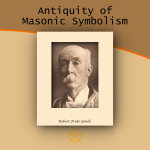 On the Antiquity of Masonic Symbolism Is the Symbolism of Masonry an inheritance derived from the old Masons who flourished before the era of the Grand Lodges (1717); or has it been borrowed from the Rosicrucians or others, after 1717? |
 Mason's Marks – from Egypt to Europe? Mason's marks have been a source of intrigue, not only to Freemasons but to historians and archaeologists. The use of simple pictograms have been employed for millennia by artisans to identify their work. But where did they originate and why? |
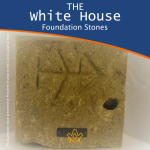 The White House Foundation Stones Further to the articles in our series on the history of the stone masons, we have a rather intriguing addition. During the 1950's renovation of the White House, President Truman retrieved more than 100 stone blocks with stonemasons marks. |
 What the Goose and Gridiron Tavern is in the ancient annals of London Freemasonry, The Green Dragon Tavern is to the memories of the Free-mason, of Boston and New England. |
 Auschwitz concentration camp: video photo article taken in 2013 |
 There are two things of importance happening this day - 27 January |
 Two approaches regarding the understanding of Freemasonry |
 Masonic Research in England c1930 An article which appeared in an American Masonic magazine, c1930 and which was reproduced in England, provoking a little controversy. |
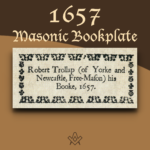 Masonic bookplates the ‘Brethren’s spiritual coats of arms and marks’ |
 The Unlawful Societies Act of 1799 Rebellious Freemasons and the 21st century |
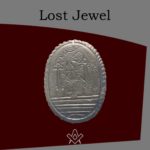 In 1912, Sarah Dowd of Dromore, Ireland, found a Masonic jewel dated 1517 - a date two hundred years before the establishment of Grand Lodge... |
 Freemasonry and Fascist Regime Interesting speech by the famous historian Prof. Aldo A. Mola, who links the fascist regime with the Masonic Associations. |
 Was famous Russian poet Alexander Pushkin a Freemason? And if so, was he a member of the lodge ‘for which all the lodges in Russia were destroyed’? |
 The Importance of Masonic Research Why is accurate - or authentic - Masonic research so important? The importance of making a daily advancement in Masonic knowledge is something that The Square is passionate about promoting. |
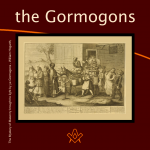 The Antient Noble Order of the Gormogons had a brief existence in the eighteenth century; they left few records or accomplishments, |
masonic knowledge
to be a better citizen of the world
share the square with two brothers

click image to open email app on mobile device






